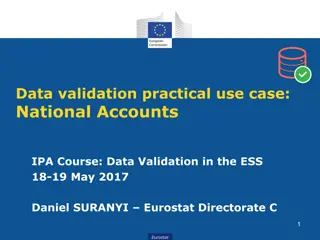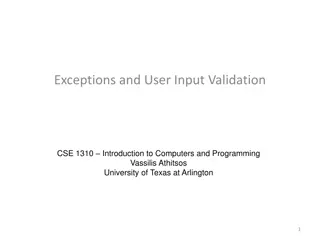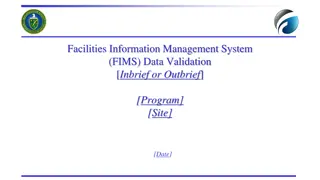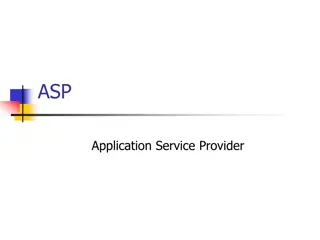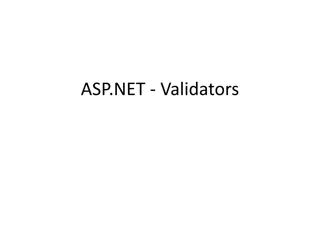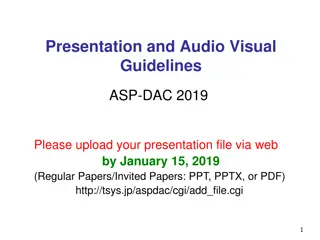Understanding Validation Controls in ASP.NET for Secure Data Input
Explore the significance of validation controls in ASP.NET to prevent user input errors and ensure data security. Learn about the types of validators, server-side vs. client-side validation, key properties, and best practices for implementing secure data validation in your web applications.
Download Presentation

Please find below an Image/Link to download the presentation.
The content on the website is provided AS IS for your information and personal use only. It may not be sold, licensed, or shared on other websites without obtaining consent from the author. Download presentation by click this link. If you encounter any issues during the download, it is possible that the publisher has removed the file from their server.
E N D
Presentation Transcript
ITEC 420 Validation & Rich Controls
Validation Why we need Validation ? Users might ignore an important field. Users might try to type short string of nonsense to circumvent a required field (like e-mail). Users might make an honest mistake, such as entering a typing error, entering a non-numeric character in numeric field. Malicious users might try to exploit a weakness in your code by entering carefully structured wrong values (like sql injection).
Validator Controls Asp.NET provides five validator controls. Four of these are tagetted at specific types of validation, while the fifth allows you to apply custom validation routines. Each validation control can be bound to a single input control. In addition, you can apply more than one validation control to the same input control to provide multiple types of validation.
Validation Controls Behaviour RangeValidator, Compare Validator and RegularExpressionValidator, validations will automatically succeed if the input control is empty due to the lack of value to validate. If that is not the behaviour you want, you should also add a Required field validator and link to the same input control.
Server Side Validation & Client Side Validation When a user clicks a button to submit submit the page depending on the buttons CausesValidation property, which can be set to True or False. If True (default one): ASP.NET will automatically validate the page when user clicks the button. It does this by performing the validation for each control on the page. If any control fails to validate, ASP.NET will return the page with some error information,depending on your settings. Click event-code may or may not be executed. - You have to specifically check in the event handler whether the page is valid (p.s. Page.IsValid) In most modern browsers ASP.NET automatically adds JavaScript code for client-side validation. In this case as guessed without informing the server validation takes place on client side. Even if the page validates successfully on client-side, ASP.NET revalidates it when it is received at the server. (Due to the possibility of hacking javascript) ASP.NET remains secure via double validation.
Validation Controls Found in System.Web.UI.WebControls namespace. Key properties could be listed as
Validation Controls Each validator has some specific properties which must be taken into account inoerder to validate an input. Below table lists these properties.
Sample Validation Create a form with two textboxes, one button, a label control (to prove button is clicked) and a RangeValidator. Set RangeValidator so that an integer from 1 to 10 will be valid. Button has CausesValidation property set to true by default. ASP.NET handles lost focus event, when the textbox looses focus if validation fails error message will be displayed in most browsers. Problem is that: click-event will be executed, even the page is invalid. To fix such problem use on buttons click (In this sample)==> if (!RangeValidator.IsValid) return; // if we have a single validator Otherwise f (!Page.IsValid) return;
Sample Validation Place the codes below to their appropriate addresses A number (1 to 10): <asp:TextBox id="txtValidated" runat="server" /> <asp:RangeValidator id="RangeValidator" runat="server" ErrorMessage="This Number Is Not In The Range" ControlToValidate="txtValidated" MaximumValue="10" MinimumValue="1" Type="Integer" /> <br /><br /> Not validated: <asp:TextBox id="txtNotValidated" runat="server" /><br /><br /> <asp:Button id="cmdOK" runat="server" Text="OK" OnClick="cmdOK_Click" /> <br /><br /> <asp:Label id="lblMessage" runat="server" EnableViewState="False" /> Finally, here is the code that responds to the button click: protected void cmdOK_Click(Object sender, EventArgs e) { if (!Page.IsValid) return; lblMessage.Text = "cmdOK_Click event handler executed."; }
Another Sample Validation Sometimes you have a carefully designed and created web page so you are looking for another space to display validation messages. In such cases the following method may help (validation summary control): From the previous sample set the Display property of the Range Validator control to none. Add a validation summary to a suitable location. In any case, the validation summary will display even if you did not update the display property, this control is able to collect and display all error messages in case of an invalid input. If you set the text property of Range Validator control to * and error message to an detailed message and if you set display property to static or dynamic and have a validation summary. Then validation summary will display the error message while range validator displaying the *. Also HeaderText property of Validation control could be used to display a specialized title. DisplayMode property of Validation control could be arranged to displays error as bulletlist,List and Single paragraph. Using Showsummary property as false and setting Showmessagebox to true will force the error messages to be displayed in a dialog box.
Manual Validation You can create manual validation in one of three ways This sample uses the 2ndtechnique: protected void cmdOK_Click(Object sender, EventArgs e) { string errorMessage = "<b>Mistakes found:</b><br />"; // Search through the validation controls. foreach (BaseValidator ctrl in this.Validators) { if (!ctrl.IsValid) { errorMessage += ctrl.ErrorMessage + "<br />"; // Find the corresponding input control, and change // the generic Control variable into a TextBox // variable. // This allows access to the Text property. TextBox ctrlInput = (TextBox)this.FindControl(ctrl.ControlToValidate); errorMessage += " * Problem is with this input: "; errorMessage += ctrlInput.Text + "<br />"; } } lblMessage.Text = errorMessage; } Use your own code to verify the values. (not using validation controls) Disable the EnableClientScript property for each validation control. This allows an ivalid page to be submitted. Set buttons CausesValidation to false. Then you have to validate the page manually using Page.Validate() method. Then examine the IsValid property or properties, and decide what to do.
Custom Validation Sample protected void vldCode_ServerValidate(Object source, ServerValidateEventArgs args) { try { // Check whether the first three digits are divisible by seven. int val = Int32.Parse(args.Value.Substring(0, 3)); if (val % 7 == 0) { args.IsValid = true; } else { args.IsValid = false; } } catch
Validation Groups In more complex pages, you might have several distinct groups of controls, possibly in separate panels. In these situations, you may want to perform validation separately. For example, you might create a form that includes a box with login controls and a box underneath it with the controls for registering a new user. Each box includes its own submit button, and depending on which button is clicked, you want to perform the validation just for that section of the page. This scenario is possible thanks to a feature called validation groups. To create a validation group, you need to put the input controls, the validators, and the CausesValidation button controls into the same logical group. You do this by setting the ValidationGroup property of every control with the same descriptive string (such as LoginGroup or NewUserGroup ). Every control that provides a CausesValidation property also includes the ValidationGroup property.




